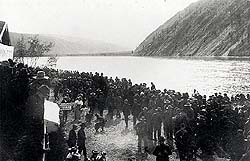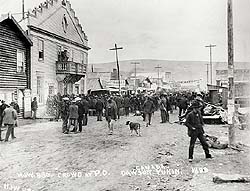 |
 
 |
 |
ORIGINS OF THE POSTAL SERVICE
IN THE YUKON
In 1896, Inspector Constantine submitted another report to Ottawa regarding the mail service in the Yukon, suggesting that the mail be sent by steamer from Victoria, British Columbia to Dyea, Alaska. From here, during the summer, the remaining distance to Fort Cudahy could likely be covered by boat; during the winter months, dog-teams could deliver the mail. Carriers would travel across the White Pass, continue on to the junction of the McClintock River and then to the junction of the Hootalinka River. They would then go on to Pelly8 and Sixty Mile, ending up at Fort Cudahy.9 "The time needed by this arrangement for the round trip would be about 35 days under favourable conditions, and would give four mails during the winter months."10
 |

Waiting for the Mail, Dawson, Yukon
Photo: LaRoche Photo
© Public domain
National Library and National Archives
of Canada, C-028634
Dawson was founded in 1896, and within two years, it became the largest Canadian town west of Winnipeg. The arrival of the mail was eagerly anticipated: people would gather to wait for the steamboat carrying it. |
As the arrival of mail was such a rare event in the Yukon, hundreds of people living in or transiting through the territory would gather to receive it. "On the arrival of mail a queue formed in which people stood for many hours, and sometimes had to return the following day. One high up in the queue could sell his place for as much as twenty dollars, and quite a lot of gold dust changed hands in the process of receiving mail."11 In August 1898, gold seeker Thomas Kay complained in a letter to his father in England about the "wretchedly poor mail service . . . when it gets here it is not distributed for a week after. This is to give the mounted police and officials time to receive [bribes] from those who are anxious enough to pay
it . . . for their mails."12
 |

Crowd Assembled at Dawson Post Office, Yukon, 1899
Photo: Henry Joseph Woodside
© Public domain
National Library and National Archives
of Canada, PA-016251
When the mail arrived, people would gather in front of the post office where they might wait for hours for their letters or packages. They sometimes had to come back the next day. |

|
 |